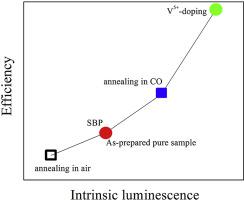当前位置:
X-MOL 学术
›
J. Alloys Compd.
›
论文详情
Our official English website, www.x-mol.net, welcomes your
feedback! (Note: you will need to create a separate account there.)
Strategy to modify intrinsic luminescence via post-annealing treatment and impurity doping in SbNb3(PO4)6
Journal of Alloys and Compounds ( IF 5.8 ) Pub Date : 2020-12-01 , DOI: 10.1016/j.jallcom.2020.156195 Suyin Zhang , Pengyue Zhang , Shan Tao , Xiaomei Zheng , Hyo Jin Seo
Journal of Alloys and Compounds ( IF 5.8 ) Pub Date : 2020-12-01 , DOI: 10.1016/j.jallcom.2020.156195 Suyin Zhang , Pengyue Zhang , Shan Tao , Xiaomei Zheng , Hyo Jin Seo

|
Abstract Self-activated luminescence of a phosphor has unique advantages such as natural homogeneity, wide wavelength, without rare-earth dopant, easy preparation, etc. However, its luminescence efficiency usually is not satisfied. This work reports several strategies to modify the intrinsic luminescence intensity of SbNb3(PO4)6 synthesized via the sol–gel method. XRD measurements were conducted to verify phase formations and structural characteristics. The transition natures and band energy were determined on the basis of the optical absorption. SbNb3(PO4)6 shows a broad self-activated luminescence (400–750 nm) peaked at 485 nm. Impurity ion V5+ doping improves the intrinsic luminescence of SbNb3(PO4)6. The optimal efficiency of 31.63% was observed in 7.0 mol% V5+-doped SbNb3(PO4)6. Post-annealing of as-prepared SbNb3(PO4)6 in the air can enhance the luminescence, while, annealing in CO atmosphere deteriorates the intensity. The luminescence thermal stabilities and activation energies were evaluated via the temperature-dependent emission intensities and decay lifetimes. The intrinsic defects such as oxygen vacancies (VO••) were confirmed via XPS measurements, which exerted great influences on the emission and thermal stabilities of the emission. The abnormal blue-shift of the emission spectra was presented from 10 to 350 K. The luminescence mechanism was proposed for the self-activated emission based on the dynamic emission spectra, decay time, and multiple color centers.
中文翻译:

通过后退火处理和 SbNb3(PO4)6 中的杂质掺杂来改变本征发光的策略
摘要 荧光粉自激发发光具有自然均匀性、波长宽、无稀土掺杂剂、制备容易等独特优点,但其发光效率往往不尽人意。这项工作报告了几种改变通过溶胶-凝胶法合成的 SbNb3(PO4)6 的固有发光强度的策略。进行XRD测量以验证相形成和结构特征。基于光吸收确定跃迁性质和带能。SbNb3(PO4)6 显示出广泛的自激活发光 (400–750 nm),峰值为 485 nm。杂质离子 V5+ 掺杂改善了 SbNb3(PO4)6 的本征发光。在 7.0 mol% V5+ 掺杂的 SbNb3(PO4)6 中观察到 31.63% 的最佳效率。在空气中对制备的 SbNb3(PO4)6 进行后退火可以增强发光,而在 CO 气氛中退火会降低强度。通过与温度相关的发射强度和衰变寿命来评估发光热稳定性和活化能。XPS测量证实了氧空位(VO••)等固有缺陷,这对发射的发射和热稳定性有很大影响。发射光谱在10~350 K范围内出现异常蓝移。基于动态发射光谱、衰减时间和多色心,提出了自激活发射的发光机制。通过与温度相关的发射强度和衰变寿命来评估发光热稳定性和活化能。XPS测量证实了氧空位(VO••)等固有缺陷,这对发射的发射和热稳定性有很大影响。发射光谱在10~350 K范围内出现异常蓝移。基于动态发射光谱、衰减时间和多色心,提出了自激活发射的发光机制。通过与温度相关的发射强度和衰变寿命来评估发光热稳定性和活化能。XPS测量证实了氧空位(VO••)等固有缺陷,这对发射的发射和热稳定性有很大影响。发射光谱在10~350 K范围内出现异常蓝移。基于动态发射光谱、衰减时间和多色心,提出了自激活发射的发光机制。
更新日期:2020-12-01
中文翻译:

通过后退火处理和 SbNb3(PO4)6 中的杂质掺杂来改变本征发光的策略
摘要 荧光粉自激发发光具有自然均匀性、波长宽、无稀土掺杂剂、制备容易等独特优点,但其发光效率往往不尽人意。这项工作报告了几种改变通过溶胶-凝胶法合成的 SbNb3(PO4)6 的固有发光强度的策略。进行XRD测量以验证相形成和结构特征。基于光吸收确定跃迁性质和带能。SbNb3(PO4)6 显示出广泛的自激活发光 (400–750 nm),峰值为 485 nm。杂质离子 V5+ 掺杂改善了 SbNb3(PO4)6 的本征发光。在 7.0 mol% V5+ 掺杂的 SbNb3(PO4)6 中观察到 31.63% 的最佳效率。在空气中对制备的 SbNb3(PO4)6 进行后退火可以增强发光,而在 CO 气氛中退火会降低强度。通过与温度相关的发射强度和衰变寿命来评估发光热稳定性和活化能。XPS测量证实了氧空位(VO••)等固有缺陷,这对发射的发射和热稳定性有很大影响。发射光谱在10~350 K范围内出现异常蓝移。基于动态发射光谱、衰减时间和多色心,提出了自激活发射的发光机制。通过与温度相关的发射强度和衰变寿命来评估发光热稳定性和活化能。XPS测量证实了氧空位(VO••)等固有缺陷,这对发射的发射和热稳定性有很大影响。发射光谱在10~350 K范围内出现异常蓝移。基于动态发射光谱、衰减时间和多色心,提出了自激活发射的发光机制。通过与温度相关的发射强度和衰变寿命来评估发光热稳定性和活化能。XPS测量证实了氧空位(VO••)等固有缺陷,这对发射的发射和热稳定性有很大影响。发射光谱在10~350 K范围内出现异常蓝移。基于动态发射光谱、衰减时间和多色心,提出了自激活发射的发光机制。











































 京公网安备 11010802027423号
京公网安备 11010802027423号